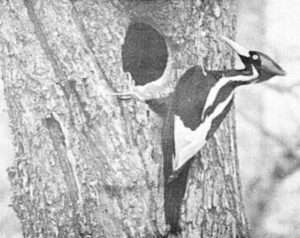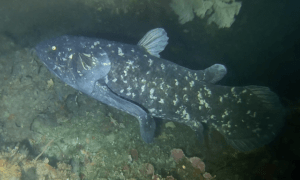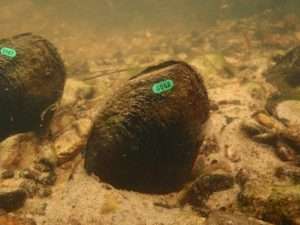
Earlier this spring, yet another claimed sighting of the ivory-billed woodpecker (Campephilus principalis) made the news. This one was particularly weighty given that it came about as part of the three-year Project Principalis, sponsored in part by the National Aviary. The Aviary’s director of conservation and field research, Steven Latta, co-authored a paper with evidence compiled from the project, which scoured Louisiana bottomlands for the bird. Both photos and video footage showed grainy depictions of woodpecker-shaped birds, but with the extant pileated woodpecker (Dryocopus pileatus) looking very similar to the larger ivory-billed, there’s a lot of skepticism about images of this quality. Still, the fact that this came out of an intensive study backed by a major avian institution rather than from casual sightings by laypeople adds some weight.
What Is–Or Was–the Ivory-Billed Woodpecker?
This species may be the holy grail for any of a number of avid birders (though Bachman’s warbler (Vermivora bachmanii) made a notable, if fictional, “grail” appearance some years back.) One of the largest woodpeckers in North America, the ivory-billed was likely never especially common, as it requires a large territory to feed itself and its young the sorts of larvae and other insects that it seeks in rotting wood. (While ivory-bills do eat a lot of berries and other plant material, insect protein is still crucial, especially in the first few weeks of life.) It’s thought to prefer old growth forests in the Southeast, but as clearcutting drove widespread deforestation in its habitat in the decades after the Civil War, the bird’s numbers dropped precipitously. Unfettered hunting prior to the passing of the Migratory Bird Treaty Act didn’t help matters either.
Most of what we know about the ivory-billed woodpecker comes from a single study from the late 1930s, when the species was all but extinct. The last confirmed sighting in the United States was in 1944, and the last in Cuba in 1986; since then sightings have been sporadic and unconfirmed. The U.S. Fish and Wildlife service is in the process of determining whether to declare the species officially extinct, and a report should be released later this year.

If the ivory-bill should turn up, it would then be considered a Lazarus species, having seemingly returned from the dead. It would join a varied cast including the coelacanth (Latimeria spp.), Wallace’s giant bee (Megachile pluto), dawn redwoods (Metasequoia glyptostroboides), and kunimasu (Oncorhynchus kawamurae), among others. It would likely be the most celebrated of these, as few assumed extinct animals have had such effort invested in their rediscovery.
The Benefits of Charisma
I think the best commentary on the most recent supposed sighting is from Kenn Kaufman, creator of the Kaufman series of field guides. While he acknowledges that the evidence, once again, is based on images of questionable quality, he brings up the importance of just how much people care about this one species of likely extinct bird. It’s not just hardcore birders who are hoping for its return; even people who might not be able to name half a dozen backyard species know about the Lord God Bird.
And he makes a very good point: “Apathy kills.” So many species have gone extinct simply because people didn’t care enough about them collectively. Individuals can care, but individuals can only do so much in the face of massive corporations and other entities made up primarily of those who are apathetic toward nature. It takes swells of public opinion, pressure, voting, and action.
It also takes money. Habitat destruction is the single biggest driver of species endangerment and extinction, and in order to protect rare species, habitat must be preserved. Unfortunately that habitat costs money, especially when timber companies covet old-growth trees, mining companies seek to tear up the ground for minerals, or housing developers want to erase ecosystems and replace them with houses and lawns. Several conservation groups have managed to buy and conserve what could be suitable habitat in the bird’s historic range, on the off chance that they still exist. But it almost seems too little too late; the last nail in the coffin may have been the apathy shown by the Singer Sewing Machine Company, who owned what may very well have been the ivory-bill’s last substantial home, and sold it to Chicago Mill who ordered it to be clearcut for timber.

Still the fervor that people feel for the potential survival of the ivory-billed woodpecker could be useful if they understand the connection between the need for habitat, and the slightest chance of a Lazarus return. More importantly, it illustrates the importance of charismatic species. Most endangered species aren’t especially flashy; the Louisiana pearlshell (Margaritifera hembeli), ringed map turtle (Graptemys oculifera), and palezone shiner (Notropis albizonatus) are just a few of the many low-profile, even supposedly “boring” species at risk within the ivory-bill’s historic range. If people are motivated to protect land for charismatic species, then that land could benefit its less flashy residents as well.
Yes, it’s a shame that most folks can only really be bothered to help the “special” animals, when they can be bothered at all. In an ideal world we’d all be much more invested in the protection and preservation of our fellow species, no matter how humble. But the perfect is the enemy of the good, and we’ve got to work with what’s here even as we continue to optimistically push for something better.
So perhaps the ivory-bill is a symbol of that hope and engagement in an otherwise apathetic society. Maybe it represents the spark of care and interest that has managed to survive a world so overwhelmed by bad news and exhaustion that it takes a flashy headline to perk anyone up any more. And who knows? It could motivate some of those people to shake off the dust and become more involved in conservation in their own way; far be it from me to gatekeep efforts to preserve and cherish what nature is left to us.
